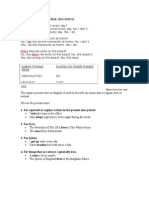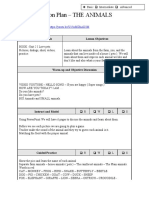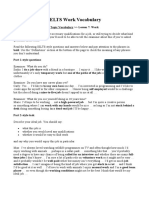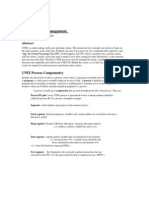Round Robin Scheduling Algorithm
Round Robin Scheduling Algorithm
Uploaded by
Jim HeffernanCopyright:
Available Formats
Round Robin Scheduling Algorithm
Round Robin Scheduling Algorithm
Uploaded by
Jim HeffernanCopyright
Available Formats
Share this document
Did you find this document useful?
Is this content inappropriate?
Copyright:
Available Formats
Round Robin Scheduling Algorithm
Round Robin Scheduling Algorithm
Uploaded by
Jim HeffernanCopyright:
Available Formats
Jim Heffernan Assignment 4 Problem of the Week # 2 Algorithm (pseudocode): (Round Robin (RR) Scheduling)
03/02/98 10:24:10 AM
let (time) quantum be 2 (sec.) ---time slice if countQueue(CPUQUEUE) equals 1 THEN --- is a process (tran) running ? if headqueue[CPUQUEUE] PCB_run equals 0 THEN --- process has completed take process off CPU if countQueue(READYQUEUE) greater than 0 THEN issue_process onto CPU decrement time quantum counter else --- process has not completed if headqueue[CPUQUEUE] time quantum equals 0 THEN --- time's up! if countQueue(READYQUEUE) greater than 0 THEN remove process from CPUQ and insert into READYQUEUE reset time quantum counter issue next available process onto CPUQ decrement time quantum counter else ----no processes (trans) in ready queue reset time quantum counter run for a tick decrement time quantum counter else ---quantum has not expi red run for a tick decrement time quantum counter else ---CPU is idle if (countQueue(READYQUEUE) greater than 0 THEN issue process onto CPU decrement time quantum counter end_if end_if end_if end_if end_if end Assumptions: -----------------1. Round Robin (RR) Scheduling Algorithm. 2. Time Slice (or time quantum) is set at 2 seconds for each user process before the next user process get control of the CPU. 3. Preemption (when process switches state) is added between processes. If a user process exceeds the time-slice it is preempted and put back on the Ready Queue. 4. Time-slice setting may affect performance: If time-slice too large - degenerates to FCFS (first-come-first-serve) and can result in the convoy effect where one process keeps the CPU until it releases; less context switching. If time-slice too small - more context switching for/to new processes.
The givens: 1. Its a FIFO Round Robin (RR) Scheduling Algorithm with a 2 second time quantum for each user process before the next user process get control of the CPU. Its preemptive - if a user process exceeds the time-slice it is preempted and put back on the Ready Queue.
2.
The Algorithm again (in my English): I come in with the list processes and loop through the scheduler function: I check to see is a process is already running (if the CPUQ = 1)? If not, I assume the CPU is idle and issue a process on the CPUQ and decrement the time quantum counter. Next, I check to see if a process has completed? If so, I take the process off the CPUQ and issue a new process and decrement the time quantum counter. Else If the process has NOT completed, I check to see if its time is up? If it is and the READYQ is greater than zero, I (1) remove the process from the CPUQ and insert itback on the READYQ, (2) reset the time quantum counter, (3) issue the next available process onto the CPUQ and (4) decrement the time quantum counter. Else If the process has NOT completed and there are no processes on the READYQ, I (1) reset the time quantum, (2) run for a tick and (3) decrement the time quantum counter. Else Finally, if the time quantum has NOT expired, I (1) run for a tick and (2) decrement the time quantum counter. I return back and execute until there are no more processes.
You might also like
- Find Me in The ClassroomDocument14 pagesFind Me in The ClassroomAlessandra YukimiNo ratings yet
- MTM Ingliz Tili Ish RejaDocument3 pagesMTM Ingliz Tili Ish RejaUmidaNo ratings yet
- OXFORDgrammar PDFDocument110 pagesOXFORDgrammar PDFJwnwns NwnsnaNo ratings yet
- Monkey PuzzleDocument2 pagesMonkey Puzzleapi-224515604No ratings yet
- The Social Network Trailer AnalysisDocument3 pagesThe Social Network Trailer AnalysiskatysthenameNo ratings yet
- LinuxCon Introduction To CloudStackDocument34 pagesLinuxCon Introduction To CloudStackLasantha JayasingheNo ratings yet
- Conditionals / Wishes / Unreal Past: 112511 Listen and Repeat. Then Act OutDocument7 pagesConditionals / Wishes / Unreal Past: 112511 Listen and Repeat. Then Act OutАрина ЕпифановаNo ratings yet
- Days of The Week Book Level1 WNBDocument9 pagesDays of The Week Book Level1 WNBНаталья СтадульскаNo ratings yet
- Monster Body Parts Reader Mishkie PDFDocument11 pagesMonster Body Parts Reader Mishkie PDFmarianneNo ratings yet
- Round UpDocument18 pagesRound UpZc0% (1)
- Fruit SaladDocument13 pagesFruit SaladMetzli RamosNo ratings yet
- The Farmer's VegetablesDocument7 pagesThe Farmer's VegetablesSvetlana TselishchevaNo ratings yet
- Story Actions 2Document6 pagesStory Actions 2ostegunNo ratings yet
- Vegetable BookDocument7 pagesVegetable BookAnonymous kQ7zl7GyFNo ratings yet
- Monster Friends: Classroom ReadersDocument11 pagesMonster Friends: Classroom ReadersBoomerang TeachersNo ratings yet
- Pumpkin Life Cycle: Written by Sarah EisenhuthDocument10 pagesPumpkin Life Cycle: Written by Sarah Eisenhuthapi-524919792No ratings yet
- Fruit SaladDocument7 pagesFruit SaladТеодора ПеневаNo ratings yet
- Kata - Completed FeedbackDocument2 pagesKata - Completed FeedbackJuan ReneNo ratings yet
- Good English Books To Read in The ClassroomDocument6 pagesGood English Books To Read in The ClassroomTanya LizNo ratings yet
- Aliens On Planet ZorgDocument10 pagesAliens On Planet ZorgТеодора Пенева100% (1)
- Lesson Plan - DemoDocument10 pagesLesson Plan - DemoChâu KýNo ratings yet
- GMF L2 Vocabulary PracticeDocument9 pagesGMF L2 Vocabulary PracticePhan Thị Cẩm NhungNo ratings yet
- .Arch16. RH - GKB - U2 - L6 - Tools - PPT - Kelly - 0207 - 200207173330Document20 pages.Arch16. RH - GKB - U2 - L6 - Tools - PPT - Kelly - 0207 - 200207173330Lady IrenaNo ratings yet
- Farm Animals 1 - 1 - ELS For KidsDocument78 pagesFarm Animals 1 - 1 - ELS For Kidseibeth.virtualassistanceNo ratings yet
- Numbers 1 10Document11 pagesNumbers 1 10agnesgawinNo ratings yet
- How Do You Feel When ... ? How Do You Feel When ... ?: Classroom ReadersDocument7 pagesHow Do You Feel When ... ? How Do You Feel When ... ?: Classroom ReadersKarinaNo ratings yet
- T T 26814 Animals On The Farm Powerpoint Ver 1Document16 pagesT T 26814 Animals On The Farm Powerpoint Ver 1paul obreinNo ratings yet
- European Day of Languages Taster SessionDocument18 pagesEuropean Day of Languages Taster SessionPaul Hasas100% (1)
- Why Do Teachers Need Lesson Plans?Document82 pagesWhy Do Teachers Need Lesson Plans?AGANAH Emmanuel100% (1)
- Lesson Plan Standard 4Document8 pagesLesson Plan Standard 4Zaty RusliNo ratings yet
- The Watanabe FamilyDocument2 pagesThe Watanabe FamilyGINNA PAOLA SANCHEZ FRANCONo ratings yet
- Irregular PluralsDocument1 pageIrregular PluralsGeorgiana GrigoreNo ratings yet
- Observation Task 1 Chit ChatDocument2 pagesObservation Task 1 Chit Chatapi-317031951No ratings yet
- 1st Conditional QuizDocument2 pages1st Conditional QuizRhoda Rose LimNo ratings yet
- English GrammarDocument24 pagesEnglish GrammarjorgeNo ratings yet
- Alphabet Book Level0 VQKDocument6 pagesAlphabet Book Level0 VQKRamona HosuNo ratings yet
- Jobs-2 3Document58 pagesJobs-2 3Kamila PlazaNo ratings yet
- Iss1 TBDocument96 pagesIss1 TBBee ChickNo ratings yet
- Farm Animals Sheets Level0 FCQ PDFDocument14 pagesFarm Animals Sheets Level0 FCQ PDFAdinaCojan0% (1)
- CLASSROOM - OBSERVATION - FORM - With ESL and Differentiated Instruction ComponentDocument1 pageCLASSROOM - OBSERVATION - FORM - With ESL and Differentiated Instruction ComponentSothea KongNo ratings yet
- Teaching Kids Objects Around The Classroom Lesson PlanDocument3 pagesTeaching Kids Objects Around The Classroom Lesson Plannsabrina_samadNo ratings yet
- Hat Hand House Horse Hammer: The English AlphabetDocument2 pagesHat Hand House Horse Hammer: The English Alphabetslavica_volkan100% (1)
- Time: Telling and Asking For The Time: GeneralDocument7 pagesTime: Telling and Asking For The Time: GeneralISABELNo ratings yet
- Lesson Plan - THE ANIMALS: Business/Materials Lesson ObjectivesDocument3 pagesLesson Plan - THE ANIMALS: Business/Materials Lesson Objectivesapi-520525283No ratings yet
- Easter Lesson: GeneralDocument7 pagesEaster Lesson: GeneralawanderersoulNo ratings yet
- Jobs (2 - 2)Document55 pagesJobs (2 - 2)María LugoNo ratings yet
- Flyers SpeakingDocument17 pagesFlyers Speakinglài nguyễn thịNo ratings yet
- Easter LessonDocument7 pagesEaster LessonSol PeiranoNo ratings yet
- Grammar in A NutshellDocument5 pagesGrammar in A NutshellBotca GeorgetaNo ratings yet
- Jobs (2 - 1)Document56 pagesJobs (2 - 1)Yasser De BruyneNo ratings yet
- IELTS Work VocabularyDocument3 pagesIELTS Work Vocabularyjesus serrano serrano0% (1)
- The Two Giants. Term 2 Week 6. Tamash A.E.Document8 pagesThe Two Giants. Term 2 Week 6. Tamash A.E.Айдын ТамашNo ratings yet
- Family (2 - 1)Document70 pagesFamily (2 - 1)Laura FraccaroNo ratings yet
- Grammar Friends - Present PerfectDocument8 pagesGrammar Friends - Present PerfectConstantin OpreaNo ratings yet
- NEW GRAMMAR TIME 1 - Unit 0 - Welcome To Grammar TimeDocument14 pagesNEW GRAMMAR TIME 1 - Unit 0 - Welcome To Grammar TimeNhungNo ratings yet
- Jobs Bus Level0 WJTDocument14 pagesJobs Bus Level0 WJTHannah Duncan-O'neillNo ratings yet
- Syllabus SOWDocument23 pagesSyllabus SOWLijien WongNo ratings yet
- Lesson Plan 4thDocument4 pagesLesson Plan 4thSibiceanu AureliaNo ratings yet
- English Grammar in Use 2020-184-185 PDFDocument2 pagesEnglish Grammar in Use 2020-184-185 PDFMeiling Fu100% (1)
- My First Words AlphabetDocument35 pagesMy First Words AlphabetMaria Mikhaela Mercado MalabongaNo ratings yet
- 4 SchedulingDocument37 pages4 Schedulingreply2amit1986No ratings yet
- X.25 Data Communications Service Packet Transmission ProtocolDocument9 pagesX.25 Data Communications Service Packet Transmission ProtocolJim HeffernanNo ratings yet
- Unix Process ManagementDocument9 pagesUnix Process ManagementJim HeffernanNo ratings yet
- James D. Heffernan: The Meaning of GnosticismDocument3 pagesJames D. Heffernan: The Meaning of GnosticismJim Heffernan100% (1)
- North American Indian Beliefs and PracticesDocument3 pagesNorth American Indian Beliefs and PracticesJim HeffernanNo ratings yet
- Alienation in The Advanced Industrial SocietyDocument2 pagesAlienation in The Advanced Industrial SocietyJim HeffernanNo ratings yet
- Case Study On Amazon Ec2Document30 pagesCase Study On Amazon Ec2nirav68127245100% (1)
- DevopsDocument2 pagesDevopsNasim AkhtarNo ratings yet
- Useful Mainframe Command ListDocument3 pagesUseful Mainframe Command ListAnbazhagan MurugesanNo ratings yet
- Richfaces ReferenceDocument498 pagesRichfaces ReferenceAzzoun JawharNo ratings yet
- Parallel Computing IntroductionDocument36 pagesParallel Computing IntroductionajishalfredNo ratings yet
- Cloud Service and Deployment ModelsDocument15 pagesCloud Service and Deployment ModelsdipaktanpureNo ratings yet
- Correct Answer Is: Explanation: Language - Other Persons Who Also Contributed To The Development of Java Are: PatrickDocument20 pagesCorrect Answer Is: Explanation: Language - Other Persons Who Also Contributed To The Development of Java Are: PatrickMary JosephNo ratings yet
- Cloud Computing: Off-Premise Cloud MigrationDocument79 pagesCloud Computing: Off-Premise Cloud Migrationserena_232014No ratings yet
- Weblogic 12cDocument3 pagesWeblogic 12ctofy79No ratings yet
- GTU DOS SyllabusDocument2 pagesGTU DOS SyllabusNirali DutiyaNo ratings yet
- Fork and ExecDocument9 pagesFork and Execvk_patiNo ratings yet
- Syllabus Cscie E90 Cloud Computing and IOT2016Document2 pagesSyllabus Cscie E90 Cloud Computing and IOT2016andrecoimbraNo ratings yet
- Remote Method Invocation in JavaDocument11 pagesRemote Method Invocation in JavaBalaji_SAPNo ratings yet
- JubulaDocument1 pageJubulasample00007No ratings yet
- HipiDocument4 pagesHipiRajaRam ManiNo ratings yet
- CS-520 Cloud ComputingDocument2 pagesCS-520 Cloud Computingshekhar785424No ratings yet
- CSC440M Cloud Computing Monsoon 2016-17Document6 pagesCSC440M Cloud Computing Monsoon 2016-17jayraj daveNo ratings yet
- High Powered Messaging With: James Carr Software Engineer OCIDocument37 pagesHigh Powered Messaging With: James Carr Software Engineer OCINgô Ngọc ThànhNo ratings yet
- 3.operating Systems Lab 1Document69 pages3.operating Systems Lab 1Vive Kowsal Yaniss100% (1)
- By Asadi Srinivasulu M.Tech, (PH.D) : Sree Vidyanikethan Engineering College (Autonomous)Document21 pagesBy Asadi Srinivasulu M.Tech, (PH.D) : Sree Vidyanikethan Engineering College (Autonomous)Srujan Sai100% (1)
- OS Project 1Document16 pagesOS Project 1NarayanaMunnaNo ratings yet
- Spring Boot ReferenceDocument377 pagesSpring Boot ReferenceEssidik EddoukaliNo ratings yet
- Metrics For 5000 Lines of Java CodeDocument48 pagesMetrics For 5000 Lines of Java CodeZarko AcimovicNo ratings yet
- CS/CMPE 524 - High-Performance Computing: OutlineDocument14 pagesCS/CMPE 524 - High-Performance Computing: OutlineIshan KothariNo ratings yet
- Scheduling in Distributed SystemsDocument9 pagesScheduling in Distributed SystemsArjun HajongNo ratings yet
- POSIX Threads Explained by Daniel RobbinsDocument9 pagesPOSIX Threads Explained by Daniel RobbinsJulio Rodrigo Castillo HuertaNo ratings yet
- Multi ThreadingDocument3 pagesMulti ThreadingMostafa Rabea KasebNo ratings yet
- Cloud PPT: A Framework For Controlling and Managing Hybrid Cloud Service IntegrationDocument16 pagesCloud PPT: A Framework For Controlling and Managing Hybrid Cloud Service IntegrationKalgi PatelNo ratings yet





























































































